Non-Potable Water Reuse in San Francisco
A modeling framework for decentralization
What is water reuse?
Water reuse involves treating wastewater to an appropriate standard so it can be used again in other applications rather than being discharged into an ocean, river or other water body. Water reuse has been expanding rapidly, especially in drought-prone locations such as California. Adopters view reuse as an opportunity to enhance and diversify their water portfolio by supplementing other water sources with recycled water. Water reuse can be an efficient way to provide reliable, safe, drought-resilient, local water. Non-potable reuse (NPR) Other types of water reuse include agricultural irrigation (also NPR), and indirect potable reuse, in which advanced treated water is placed in a reservoir, groundwater aquifer, or other water body that will later be used for drinking water supply. California regulations are currently being developed to allow direct potable reuse, in which advanced treated water is added directly to the drinking water distribution system. involves reusing water for applications that do not require high quality water such as toilet flushing and irrigation. NPR has lower treatment requirements than are needed for potable reuse, but requires the construction and installation of a separate, non-potable, distribution system for the recycled water.
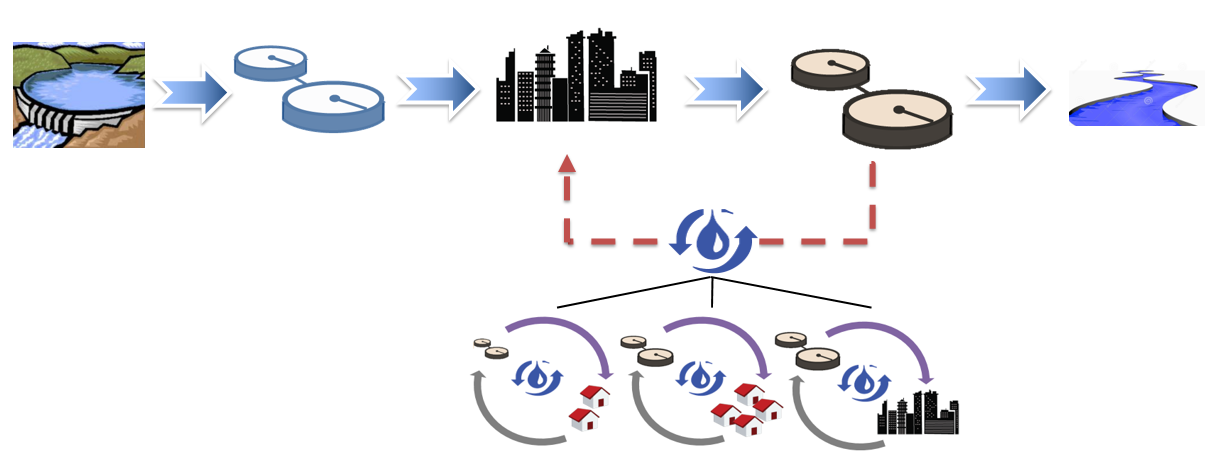
What factors affect the environmental impacts of non-potable water reuse?
Managing water is often an energy-intensive activity. Recycled water needs to be collected, treated and re-distributed to customers, processes that all require material and energy inputs and emit greenhouse gases (GHG) at the site of implementation and throughout the life-cycle. As concerns over energy reliability (i.e., matching supply and demand for electricity in real-time) and climate change increase, using a life-cycle approach to assess the impacts of new water supply and infrastructure is critical.
Another important consideration is the size of the system. Non-potable water reuse can be implemented at different scales, from a single house to an entire city or region. Larger, or centralized, systems are generally managed by the local wastewater utility and involve treatment facilities co-located or near a wastewater treatment plant connected to miles of distribution piping to deliver the recycled water to customers. Smaller, decentralized plants may be managed by a utility, a property owner, or other entity, depending on local practice, and generally serve a single building, a neighborhood, or small community, and the water is reused in and around the same buildings where it was generated. The definitions of centralized and decentralized systems are not well-established and agreed-upon in the engineering and planning communities but we have used the above definitions for our work.
Larger systems benefit from "economies of scale" because the treatment takes place in large facilities that are generally more efficient. The tradeoff is that larger scale systems require more infrastructure and, often, more pumping for both the wastewater being collected and the treated water being distributed as they are generally located further from the customer. This tradeoff is generally understood but has been poorly analyzed because it depends on many site-specific factors: land use, water demands, population density, and topography to name a few. Spatial analysis along with a life-cycle assessment (LCA) of the required infrastructure is needed to identify options that increase water resiliency while minimizing environmental impacts.
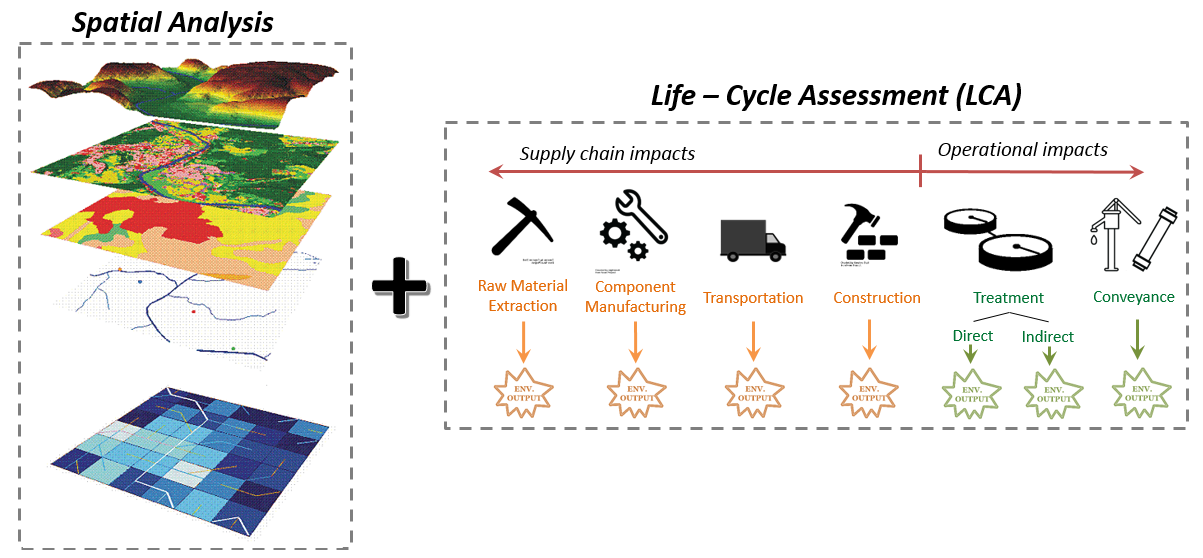
How is San Francisco promoting non-potable reuse?
San Francisco Public Utilities Commission (SFPUC), the city’s water and wastewater utility, has been a leader for exploring and adopting innovative approaches to diversify their water supply. Through conservation, the city has reduced residential per capita water consumption to 44 gallons per person per day, one of the lowest reported levels in the state. To further reduce water use, the city championed the practice of NPR in buildings and at the district-scale, allowing the collection, treatment, and use of alternate water sources for non-potable applications such as toilet flushing and landscape irrigation. As of Nov 1, 2016, all new buildings over 250,000 square feet of gross floor area are required to install NPR systems to treat and reuse available alternate water sources for toilet flushing and irrigation
What were the goals of the study?
This study combines spatial analysis and a LCA methodology to estimate environmental impacts of decentralized versus centralized non-potable water reuse for toilet flushing, using San Francisco as a case study. Specifically, we wanted to understand the tradeoff between having smaller conveyance system for decentralized NPR versus the efficiency in the treatment process as the amount of water treated increases. We created a methodology to quantify these tradeoffs and define minimum efficient scales for decentralized water reuse systems. We used LCA to evaluate the selected metrics: Our assessment considered the lifecycle impacts associated with the construction, operation and maintenance of NPR pipes (including excavation and backfilling for average trench depths for the selected pipe diameter), storage tanks, additional treatment facilities (i.e., the construction of the existing wastewater treatment plants was excluded), pumps for sewage collection and NPR distribution, and production and transportation of materials. Marginal operational energy and chemical use from the existing wastewater treatment plants was also included. the energy use and GHG emissions of residential water reuse.
To create a functionally equivalent comparison, the study compares decentralized systems implemented over a range of scales with centralized water reuse at both of SFPUC’s two wastewater treatment plants for the city’s diverse spatial conditions (e.g., topography and population density). The framework can be used as a planning support tool to integrate decentralized infrastructure for water reuse into any urban setting with existing centralized wastewater infrastructure while considering energy and GHGs.
Where does decentralized reuse make most sense in San Francisco?
The figure below visualizes the results of the analysis. Green cells denote places where smaller-scale reuse makes the most sense. Red indicates that centralized reuse will make more sense at all scales. More specifically, the colors identify the minimum system scale where decentralized reuse has lower impacts than centralized reuse. If decentralized NPR were to be implemented at a scale equal to or greater than the size indicated (in units of m3/day) in the specific area of the city shown on the grid, it will be more energy efficient than connecting to reuse from the centralized treatment plant. At the minimum scale and larger, the impact of water conveyance from the distant wastewater treatment plant outweighs the treatment economies of scale making a small decentralized system more efficient overall.
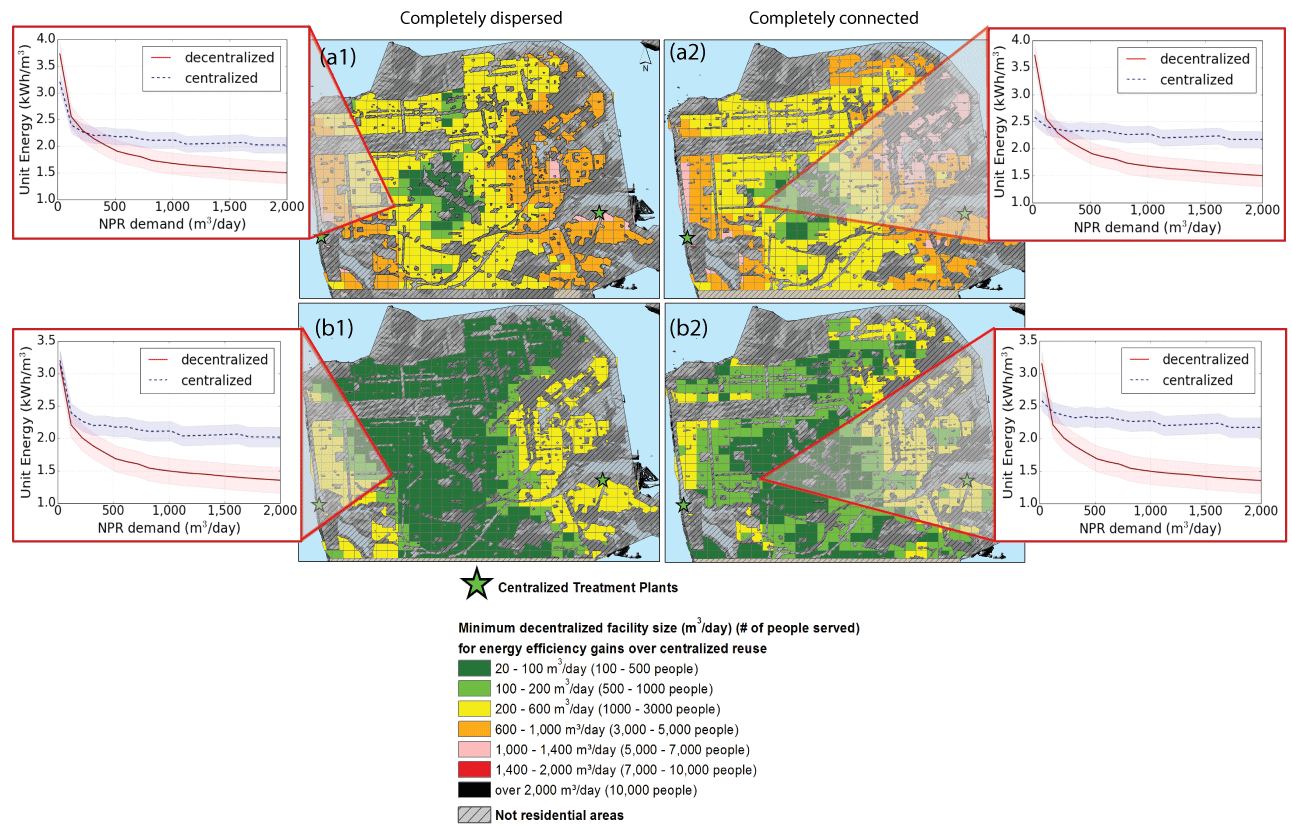
Because a centralized NPR distribution network at the scales and locations we evaluated has not been considered by SFPUC, it is difficult to predict exactly what it would look like and how efficiently it would function. To account for this uncertainty, we analyzed two extreme case to serve as upper and lower bounds for the centralized network. The “completely connected” scenario (shown on the right of the figure in a2 and b2) assumes all grid cells are connected to meet their demand in an optimum way. This ensures that piping is shared between multiple grid cells, minimizing the effects of treated water distribution and creating a lower bound. The upper bound is defined by the “completely dispersed” scenario (a1 and b1) which assumes each cell is connected to the centralized treatment plant individually.
Why does this matter?
Water infrastructure, once constructed, lasts for decades. The systems we implement today will affect energy consumption and GHG emissions for years to come. These long term effects must be explicitly considered in our planning and design choices.
All water infrastructure is spatially sensitive. Optimal solutions could vary depending on location, scale, number of facilities and topography. Because centralized wastewater treatment plants are typically located at low elevations (to ensure gravity flow of sewage) and at the outskirts of the cities, water reuse systems are particularly sensitive to energy needed to reach the customer. Although small systems are less efficient in treatment efficiency, they benefit from being closer to the point of use, avoiding the conveyance energy and GHG penalty. By carefully assessing the spatial conditions in which NPR exists we can identify optimal solutions that minimize the environmental impacts now and in the future.
As this work shows, system scale should be coupled with the specific spatial parameters to identify optimal system designs. Not surprisingly, even relatively small decentralized systems have lower energy and GHG footprints in some areas based on the specific topography and distance from the centralized treatment facility. More research is needed to reduce the uncertainty of the analysis as only certain treatment processes were assessed and, because few data are available, all energy intensities are uncertain. Last but not least, societal impacts play an important role in the decision making process.
Centralized infrastructure, though perceived as more reliable and efficient, presents barriers for NPR because large scale dual-distribution systems can be costly and disruptive to implement in dense urban areas. Decentralized infrastructure allows for a flexible and incremental approach for system expansion with uncertain growth patterns and can increase community engagement.
I want to know more. What exactly is driving these results?
The figure below shows our results for the contribution of each component to the total energy and GHG emissions for the decentralized and centralized scenario for a representative area 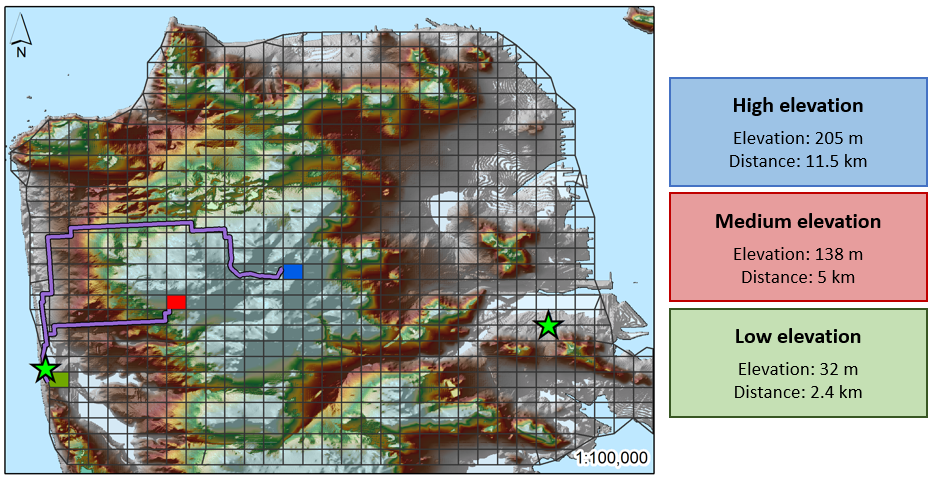 of San Francisco.
of San Francisco.
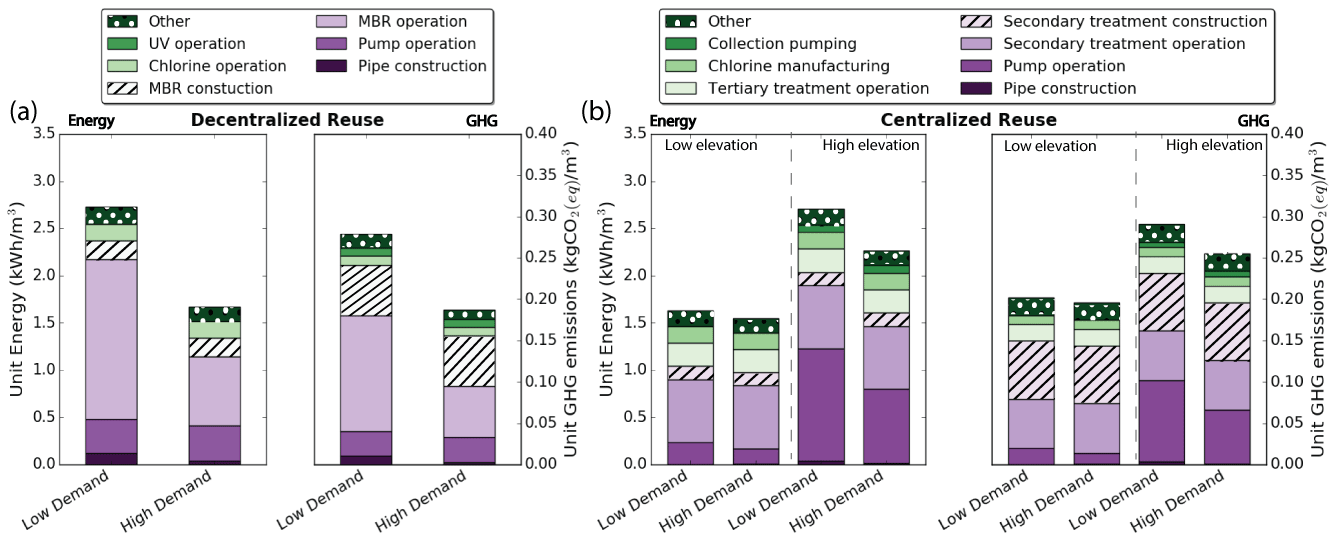
I want to know even more. Can you tell me more about the details of your study?
To appropriately model the specific case study of San Francisco, we divided the city into small grid cells (500 m x 500 m; see figure). In each one we evaluated the performance of a decentralized water reuse system at different scales (from 20 to 2,000 m3/day) with centralized water reuse. In each grid cell we accounted for the location-specific topography and population density. The number of people served refers to the number of people whose wastewater is needed to generate enough reused water to meet non-potable demand. We accounted for the wastewater generation and recycled water demand separately as the NPR water will only meet approximately 50% of the total residential demand in San Francisco. To provide a realistic comparison, we modeled different treatment systems for the decentralized approach and the centralized approach. For the decentralized approach we assumed an MBR system, combined with appropriate pretreatment and disinfection. For the centralized treatment, we assumed SFPUC’s existing secondary treatment is coupled with tertiary treatment (granular media filtration) to meet NPR regulations, and includes reverse osmosis to reduce salinity due to saltwater intrusion into the sewer system. The tertiary treatment is only applied to the portion of the water destined for reuse.
The decentralized distribution system was modeled based on average city block sizes and specific population density to estimate the required piping infrastructure and pumping needs for each system scale. The centralized distribution was modeled based on the existing street network and calculating the necessary piping infrastructure based on the shortest path (Dijkstra's algorithm) between each grid cell and the closest centralized wastewater treatment plant. The pumping needs were estimated based on the overall elevation difference between the grid cell and the treatment plant accounting for the elevation head, velocity head, consumption pressure and head losses. The route elevation was also considered when estimating the connecting path between grid cell and treatment plant to identify the route with the minimum piping and pumping requirements.
Relevant Work
This work builds on previous published research. The findings and results of the original study can be found in the Environmental Science and Technology Journal under the titled publication Assessing Location and Scale of Urban Non-Potable Water Reuse Systems for Life-Cycle Energy Consumption and Greenhouse Gas Emissions. In the paper, we assumed that tertiary treatment for centralized reuse consisted only of granular media filtration and disinfection, which meets California’s non-potable reuse regulations, and is typically the process applied for non-potable reuse. However, due to saltwater intrusion in San Francisco’s sewers, reverse osmosis is also needed. The results presented here account for this additional treatment.
The funding for this research was provided by the National Science Foundation-funded Reinventing the Nation’s Urban Water Infrastructure (ReNUWIt) Engineering Research Center. Any opinions, findings, and conclusions or recommendations expressed in this material are those of the named authors and do not necessarily reflect the views of the NSF.
The authors would like to thank the San Francisco Public Utilities Commission (SFPUC) for their cooperation and data sharing that made this work possible. The results and findings are solely those of the authors, and not SFPUC.
Authors Bios
Olga Kavvada is a phD Student in Civil and Environmental Engineering at U.C. Berkeley. Her work involves systems-level analysis to improve our usage of energy and water resources under the constraints of climate change.
Dr. Kara Nelson is a professor of Civil and Environmental Engineering at U.C. Berkeley. Her teaching and research address innovative strategies to increase the sustainability of urban water infrastructure around the world. She leads the engineering research thrust at ReNUWIt.
Dr. Jennifer R. Stokes-Draut is a Research Engineer in Civil and Environmental Engineering at UC Berkeley. She studies the life-cycle energy and environmental impacts and tradeoffs associated with water and wastewater infrastructure under current and uncertain future conditions.
Dr. Arpad Horvath is a professor of Civil and Environmental Engineering at UC Berkeley. His teaching and research involves life-cycle environmental and economic assessment of products, processes, and services to answer important questions about civil infrastructure systems and the built environment.
Dr. William A. Eisenstein leads the urban systems and institutions research thrust in ReNUWIt. He is the executive director of the Center for Resource Efficient Communities at UC-Berkeley, which focuses on strategies to reduce the water, energy, and greenhouse-gas intensity of cities.
Dr. Thomas P. Hendrickson is a technical specialist at ICF in San Francisco. He specializes in environmental mitigation and climate adaptation assessments of complex infrastructure systems, with a focus on identifying resilience solutions for water and wastewater systems.
Support or Contact
Do you have questions or comments? Please contact Olga Kavvada: @okavvada or email okavvada@gmail.com.